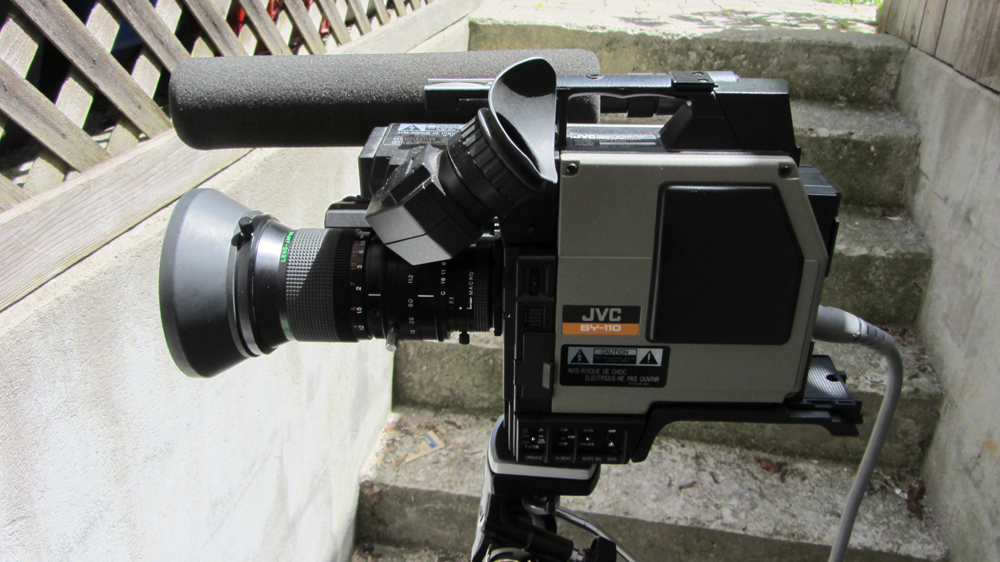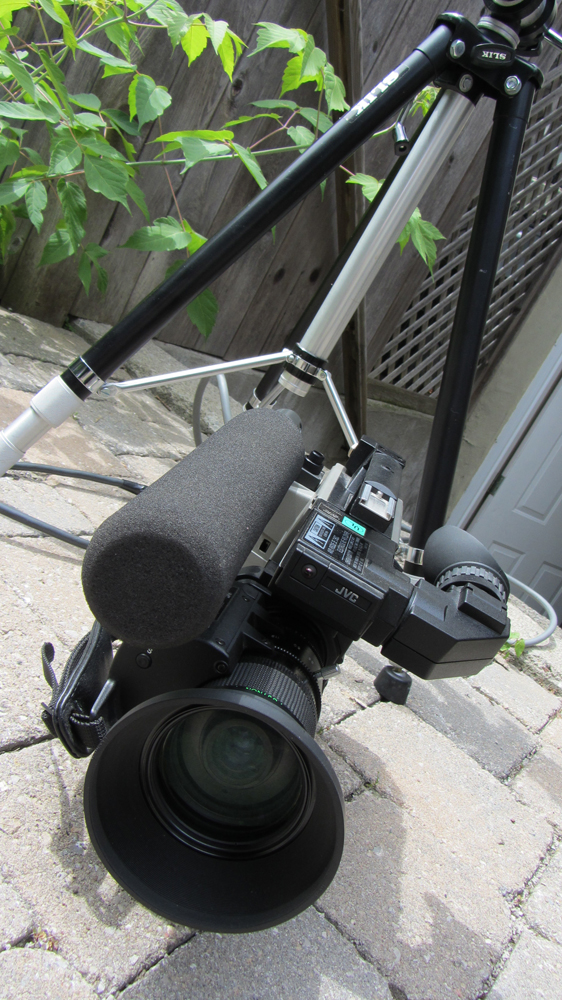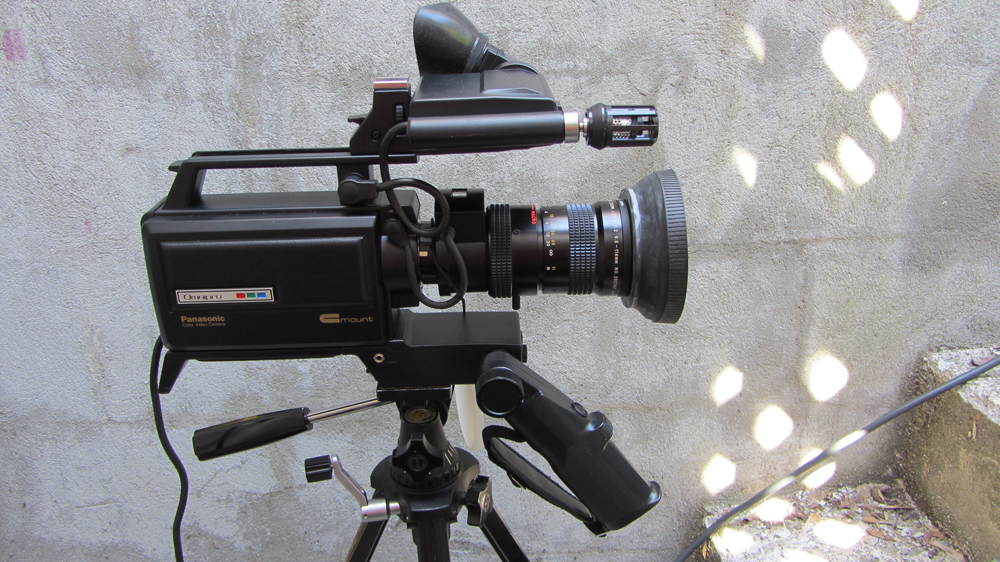Camera Tests #104 a/b: JVC BY-110UL16

When JVC brought out its BY-110UL16 (aka, model BY-110), a smaller, cheaper, yet still pretty damn good 3-tube camera (the unit is outfitted with three 1/2 inch Saticon tubes instead of the bigger and more popular 2/3 versions), it was around the time ENG cameras were starting to be available in both tube and CCD variants, and not long afterwards, units that were either standalone cameras or modular camcorders capable of recording in VHS, SVHS, U-matic, and Betcam.
The usage of different type of tubes also seemed to indicate that Saticons were for Important Things, and Newvicons, being more burn-resilient and better in low-light situations, were preferred for night shoots.
In preparation for an upcoming shoot, I did some test filming over the past two weekends, partially to see how the camera handled bright exterior sunlight and a harsh spotlight in otherwise dark locales. Being a classic standalone camera in need of a power supply (the original chunky batteries are long dead) and a separate video recorder, the most accessible locations were the 1) backyard, and 2) the home.
It’s a real challenge trying to figure out how to take a vintage camera to a location and find the simplest means to both power it + record SD footage for editing in an HD project. The BY-110, like other similar cameras, needs its own unique accoutrements that make it almost impractical in 2014, but I’m hoping the end results will justify the headache in coordinating the transportation, setting up, striking down, and returning home of said chunky gear.
(I do have fond memories of the simplicity in having to carry a camcorder + tripod, and maybe an extension cord to get the job done. Way, WAY back, I taped two years of fFIDA dance performances, and going back & forth was easier because the gear was smaller & lighter, and easy parking was still possible in T.O.)
In any event, I’ve uploaded the two sets of videos:
Headshots on Vimeo:
Headshots on YouTube:
The Garden Colours version on Vimeo will be up in a week’s time, but you can access the same montage in HD on YouTube:
A few more photos of the garden shoot are on my Flickr page, and I’ll have a follow-up blog on how the camera performed in mid-July.
As for the above videos, all the footage was recorded straight to miniDV using a Sony GV-D1000 watchman (somehow Sony’s use of that moniker seems out-of-place when applied to prosumer gear), and edited in Adobe Premiere.
None of the Headshots footage was treated – what’s in the video is the raw footage – but I did do some slight colour correction on the garden footage because there were inconsistencies due to the changes in lights, and my erroneous use of the camera’s built-in 5600 K / 25% ND combo filter.
One thing that did mandate some reshooting was underexposed footage because what seemed hot in the viewfinder was actually the right exposure to get good colour and overall brightness. Classic case of what the camera’s systems says is safe and reasonable actually isn’t. I didn’t have any polarizer or ND variants for the lens size (77mm), so there were some shots in which capturing detail necessitated a few somewhat hot whites.
Other point: I used a vintage Slik tripod (model 312V) which handles broadcast cameras – in weight, bulk, length – extremely well. Without a greased tripod head, the tilts and pans aren’t fluid – you have to make your own resistance to get those movements that glide instead of ‘swoop.’ Panning is less a problem, but my beat-up 35mm Black’s tripod from high school (it still works!) is great for panning but way too small for ENG cameras.

The Slik is a sturdy, solid tripod good for locked shots at medium and high heights (when both legs are extended, you’ll need a stool to set up a shot), and it isn’t too heavy because of its aluminum build, but it’s not a tripod for creating elegant, smooth camera movements; locking off a bulky JVC KY-1900 at a steep angle is fine, however, making this one a keeper for cameras of that type.
I bought the Slik for $25, and I think the matching dolly (which has nice, smooth rubber wheels) was $19 on Ebay. The JVC BY-110U was about $56, which included camera + case + power supply + 2 batteries [dead] + 14-pin to 10 pin cable + camera case. Shipping to Canada cost about the same as a down-payment on a small condo.
Well, not really, but expect any international shipping to exceed the value of your goods. Most vintage gear comes from the U.S., although once in a while something within Canada shows up (which is always great because the shipping is much more reasonable).
In a future blog I’ll get into more details about finding not only gear on Ebay, but scrounging for information on some of the many odd things that materialize online. Most of what’s for sale lacks manuals, most sellers aren’t familiar with the cameras, most cameras lack power supplies and cables, and it’s a crapshoot as to whether what you buy will in fact function.
In most cases, they will. Only 1 camera I’ve bought was outright D.O.A., and there are those which may die soon after turning on a few times. You’re potentially buying a camera that’s been unused for decades, and maybe spent time in storage that’s clean or outright filthy, or other unknowns.
One project I’m working on in small bits is a camera (a 1982 Panasonic PK-972) that’s in impeccable cosmetic condition, but likely due to years of disuse its capacitors probably need full replacement, and maybe the tube is toast. I managed to get it to turn out a stable picture, but placing it in the garden for some filming provided some striking aberrations. However, after its time in the garden, this great-looking camera is no longer putting out a stable picture.

It does force anyone interested in buying old yet functional cameras to ask him / herself several questions: Are you planning on using it for projects, or as a museum piece? Do you care about further wear & tear, or is it a camera purely for interior use under the safest conditions?
It’s not unusual to get a camera that’s been beautifully cared for, including its case, and you may find yourself struggling with whether to risk adding wear to something in sometimes near-mint condition, or treating like an artifact.
Tough choices, especially since components like tubes will eventually die. I guess the plus side of most cameras made up to the late 80s / early 90s is how they’re all made in Japan, from the electronics to the lenses, and even printed manuals. At one time Panasonic was a major supplier of consumer home video gear, and it’s astonishing to see “Made in Japan” stamped on so many components across so many name brands.
If the build of these cameras (and lenses) are any indication, certainly with ENG cameras, you’re kind of buying a tank. Not unlike a classic Honda or VW bug, it’s amazing that something with dents, scratches, and gouges on the body, worn logos, peeling side padding, disintegrated mic foam, and dinged-up switches still works.
Cheers,
Mark R. Hasan, Editor
Big Head Amusements
